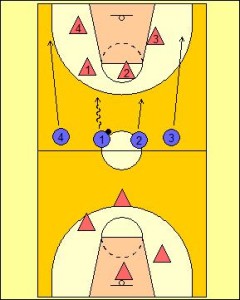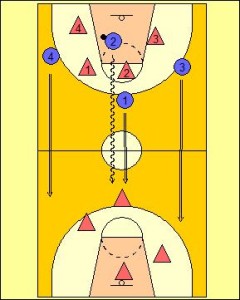4 v 4 v 4 Continuous Drill
The 4 v 4 v 4 Continuous Drill is a fantastic drill for getting more players on the court and moving at one time. The drill sees three groups of four players match-up against one another in a scenario that allows for ongoing periods of play. The 4 v 4 v 4 Continuous Drill can have a defensive or offensive focus and can features aspects like breakdowns of fast break principles or execution of half court offensive plays.
The 4 v 4 v 4 Continuous Drill is a great drill for making your players undertake a number of live play scenarios in a row. This is a highly valuable aspect of the drill as often when a number of game-like situations are linked together the player performance can become very sloppy and undisciplined. The 4 v 4 v 4 Continuous Drill allows for short bursts of activity, but these sequences of intensity (possession) will be broken by rest and time to compose (defensive periods after losing possession).
Unlike dual team drills or games where the full court is used by two teams, the 4 v 4 v 4 Continuous Drill allows for a coach to deliver feedback to a group while play carries on to the alternate end of the floor. This seems like a small point, but provides a valuable opportunity for coaching on the run to happen but at an extended period so some real focus points can be delivered to the players on the floor.
One of the strengths of the 4 v 4 v 4 Continuous Drill is the sheer number of variations that can be made to the drill’s format to provide different prospects by the drill as a vehicle for development. Some of the options that can be changed within the drill include:
- Number of Players within Teams; teams of three or Teams of five can also be used
- Defensive Possibilities; if a team scores, defence can be added so they must inbound the ball and progress it up the floor under pressure. Alternatively, the team at the opposite end of the floor can start to play defence from the halfway line
- Targets; goals such as the first five can be given or the first team to have five “stops”
If there are additional players still not on the floor, these can be used as substitutions for each team. Provided there are enough players however, these additional players can form a team and wait out of bounds at one of the ends of the court for a team to loose and then substitute in for this losing team. By using this strategy up to as many as twenty players in groups of four can be managed comfortably on one court.

The set-up for the 4 v 4 v 4 Continuous Drill starts with three teams of four players moving onto the floor.
Two teams move to opposite ends of the floor, while one group of four remains at the halfway line with the basketball.
The team with the basketball can choose to go to either end to start the drill.
Once the ball crosses halfway, the 4 v 4 situations are “live” from that point on.
Teams play until either the offensive team scores or the defensive team achieves a “stop”. Whoever has possession then dribbles the ball to the opposite end of the floor to start the next 4 v 4 match-up.

When the drill is first implemented, it is suggested that the team who secures possession (either through the score or stop) has a free run to halfway. This should be changed though as a team becomes more competent and can face greater defensive pressure.
The 4 v 4 scenarios continue to play out on both ends of the floor continuously until the target set by the coach is achieved.
Possible starting targets include:
- First team to five scores
- First team to five stops
The 4 v 4 v 4 Continuous Drill is fantastic for teams practicing against different Zone Defence formations at opposite ends of the floor. In this situation ensure teams instead of having four players have five.






